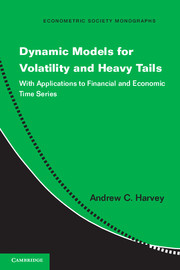 Dynamic Models for Volatility and Heavy Tails
Dynamic Models for Volatility and Heavy Tails Book contents
- Frontmatter
- Contents
- Preface
- Acronyms and Abbreviations
- 1 Introduction
- 2 Statistical Distributions and Asymptotic Theory
- 3 Location
- 4 Scale
- 5 Location/Scale Models for Non-negative Variables
- 6 Dynamic Kernel Density Estimation and Time-Varying Quantiles
- 7 Multivariate Models, Correlation and Association
- 8 Conclusions and Further Directions
- A Derivation of Formulae in the Information Matrix
- B Autocorrelation Functions
- C GED Information Matrix
- D The Order of GARCH Models
- E Computer Programs
- Bibliography
- Author Index
- Subject Index
- Other titles in the series
Preface
Published online by Cambridge University Press: 05 May 2013
- Frontmatter
- Contents
- Preface
- Acronyms and Abbreviations
- 1 Introduction
- 2 Statistical Distributions and Asymptotic Theory
- 3 Location
- 4 Scale
- 5 Location/Scale Models for Non-negative Variables
- 6 Dynamic Kernel Density Estimation and Time-Varying Quantiles
- 7 Multivariate Models, Correlation and Association
- 8 Conclusions and Further Directions
- A Derivation of Formulae in the Information Matrix
- B Autocorrelation Functions
- C GED Information Matrix
- D The Order of GARCH Models
- E Computer Programs
- Bibliography
- Author Index
- Subject Index
- Other titles in the series
Summary
This book sets out a class of nonlinear time series models designed to extract a dynamic signal from noisy observations. The signal may be the level of a series or it may be a measure of scale. Changing scale is of considerable importance in financial time series where volatility clustering is an established stylized fact. Generalized autoregressive conditional heteroscedasticity (GARCH) models are widely used to extract the current variance of a series. However, using variance (or rather, standard deviation) as a measure of scale may not be appropriate for non-Gaussian (conditional) distributions. This is of some importance, because another established feature of financial returns is that they are characterized by heavy tails.
The dynamic equations in GARCH models are filters. Just as the filters for linear Gaussian location models are linear combinations of past observations, so GARCH filters, because of their Gaussian origins, are usually linear combinations of past squared observations. The models described here replace the observations or their squares by the score of the conditional distribution. Furthermore, when modelling scale, an exponential link function is employed, as in exponential GARCH (EGARCH), thereby ensuring that the filtered scale remains positive. The unifying feature of the models in the proposed class is that the asymptotic distribution of the maximum likelihood estimators is established by a single theorem that delivers an explicit analytic expression for the asymptotic covariance matrix of the estimators. Furthermore, the conditions under which the asymptotics go through are relatively straight forward to verify.
- Type
- Chapter
- Information
- Dynamic Models for Volatility and Heavy TailsWith Applications to Financial and Economic Time Series, pp. xiii - xviPublisher: Cambridge University PressPrint publication year: 2013
